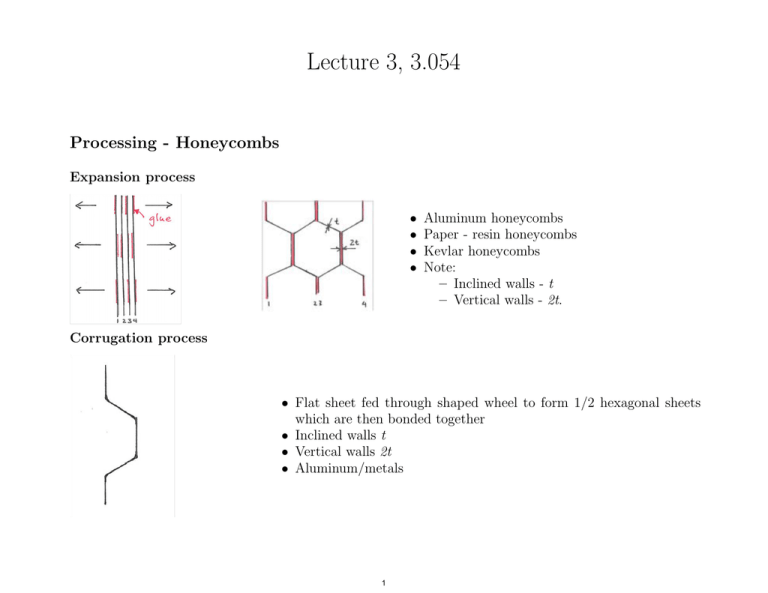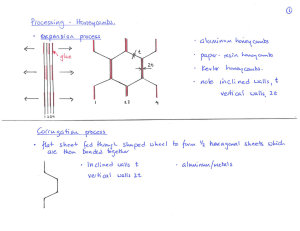
Lecture 3, 3.054
Processing - Honeycombs
Expansion process
•
•
•
•
Aluminum honeycombs
Paper - resin honeycombs
Kevlar honeycombs
Note:
– Inclined walls - t
– Vertical walls - 2t.
Corrugation process
• Flat sheet fed through shaped wheel to form 1/2 hexagonal sheets
which are then bonded together
• Inclined walls t
• Vertical walls 2t
• Aluminum/metals
1
Honeycombs: expansion and corruga7on Hobe Block
Roll
Sheet
Hobe Slice
T
b
We
Extended Panel
T
L
W
W
Expansion Process of Honeycomb Manufacture
L
Corrugated Block
L
Web
Corrugated Panel
L
L
T
Roll
Corrugating Rolls
W
W
Corrugated Sheet
T
T
Corrugation Process of Honeycomb Manufacture
Image by MIT OpenCourseWare.
Winona
State University (Course 1)
2
Honeycombs
• Extrusion process
◦ ceramic honeycombs made by extrusion of a ceramic slurry through a die
• Rapid prototyping
◦ 3D printing
◦ scan photo-sensitive polymer with laser
• Casting
◦ silicone rubber honeycombs made by casting liquid rubber into a mold
• Biocarbon template
◦ wood has honeycomb-like structure (with cell size of ∼ 50µm × 1mm)
◦ biocarbon template replicates wood structure
◦ wood is pyrolized at 800◦ C in an inert atmosphere (biocarbon template)
◦ structure is maintained, although significant shrinkage (∼ 30%)
◦ carbon replica can then be further processed, e.g., infiltrate with gaseous Si to form SiC wood
replica
◦ possible applications: high temperature filters, catalyst carriers
◦ small cell size gives high surface area/volume
3
Honeycomb extrusion Image © Fraunhofer-Gesellschaft. All rights reserved. This content is excluded from our
Creative Commons license. For more information, see http://ocw.mit.edu/help/faq-fair-use/.
www.ikts.fraunhofer.de 4
Printing honeycomb specimens
Square honeycomb Hexagonal honeycomb Triangular honeycomb 200 µm nozzle 6 mm/s nozzle speed Brett Compton and Jennifer Lewis, Harvard 126 psi Courtesy of Brett Compton and Jennifer Lewis. Used with permission.
5
Honeycomb specimens
~50 layers 4 mm m 19 m
Brett Compton and Jennifer Lewis, Harvard Relative density ~0.25 Courtesy of Brett Compton and Jennifer Lewis. Used with permission.
6
Biocarbon template Source: Zolfrank, Cordt, and Heino Sieber. "Microstructure and Phase Morphology
of Wood Derived Biomorphous SiSiC-ceramics." Journal of the European Ceramic
Society 24 (2004): 495. Courtesy of Elsevier. Used with permission.
Zollfrank and Sieber (2004) J Europ Ceram Soc 24 495 Source: Vogli, E., H. Sieber, and P. Griel. "Biomorphic SiC-ceramic Prepared
by Si-vapor Phaseinfiltration of Wood." Journal of the European Ceramic
Society 22 (2002): 2663. Courtesy of Elsevier. Used with permission.
Vogli Sieber and Griel (2002) J Europ Ceram Soc 22, 2263 7
Foams
• Different techniques for different types of solids
Polymer Foams
• Introduce gas bubbles into liquid monomer or polymer; allow bubbles to grow and stabilize and
solidify by cross-linking or cooling
• Gas introduced by either mechanical stirring or mixing blowing agent into the polymer
• Physical blowing agents (e.g. CO2 , N2 ) forced into solution in hot polymer at high pressure, then
expanded into bubbles by reducing pressure
◦ Or, low melting point liquids (e.g. methyl chloride) mixed into polymer, then volatilized on
heating to form vapor bubbles
• Chemical blowing agents: either decompose or heating or combine to release gas
• Open/closed cell structure depends on rheology and surface tension of melt
• Syntactic foams: thin-walled hollow microspheres in polymer
8
Polymer Foams
• Polymer foams sometimes have “skin” on surfaces
• In some cases, process is controlled to give sufficiently thick skin so that it acts like a sandwich
structure → increased stiffness and strength/weight.
Metal Foams
• Bubbling gas into molten Al, stabilized by SiC or Al2 O3 particles
◦ Particles increase the viscosity of the melt, reducing drainage from gravity, then stabilizing
bubbles until solidification occurs
• Consolidation of metal powder (e.g., Al) with particulate T iH2 , followed by heating; T iH2 releases
H2 gas, expanding the material
• Or, T iH2 can be stirred into molten metal and then pressure-controlled during cooling
• Infiltration of metal into open cell mold; fill open cell polymer foam with sand; burn off foam;
infiltrate with metal; remove sand
• Vapor phase deposition of electrodeposition of metal onto polymer foam precursor (which is subsequently burned out
• Trapping of high pressure inert gas in pores by powder hot isostatic pressing, followed by expansion
of gas at elevated temperature
9
Bubbling of gas into molten Al Figure removed due to copyright restrictions. See Figure 2.2: Ashby, M. F., A.
Evans, et al. Metal Foams: A Design Guide. Butterworth Heinemann, 2000.
Ashby, Evans, Fleck, Gibson, Hutchinson, Wadley (2000) Metal Foams: A Design Guide, BuUerworth Heinemann 10
Combine metal and TiH2 powder, consolidate and heat Figure removed due to copyright restrictions. See Figure 2.4: Ashby, M. F.,
A. Evans, et al. Metal Foams: A Design Guide. Butterworth Heinemann, 2000.
Ashby, Evans, Fleck, Gibson, Hutchinson, Wadley (2000) Metal Foams: A Design Guide, BuUerworth Heinemann 11
TiH2 powder in molten Al Figure removed due to copyright restrictions. See Figure 2.3: Ashby, M. F., A. Evans,
N. A. Fleck, et al. Metal Foams: A Design Guide. Butterworth Heinemann, 2000.
Ashby, Evans, Fleck, Gibson, Hutchinson, Wadley (2000) Metal Foams: A Design Guide, BuUerworth Heinemann 12
Replica7on by cas7ng Figure removed due to copyright restrictions. See Figure 2.5: Ashby, M. F., A. Evans,
N. A. Fleck, et al. Metal Foams: A Design Guide. Butterworth Heinemann, 2000.
Ashby, Evans, Fleck, Gibson, Hutchinson, Wadley (2000) Metal Foams: A Design Guide, BuUerworth Heinemann 13
Replica7on by vapour deposi7on Figure removed due to copyright restrictions. See Figure 2.6: Ashby, M. F., A. Evans,
N. A. Fleck, et al. Metal Foams: A Design Guide. Butterworth Heinemann, 2000.
Ashby, Evans, Fleck, Gibson, Hutchinson, Wadley (2000) Metal Foams: A Design Guide, BuUerworth Heinemann 14
Entrapped gas expansion Figure removed due to copyright restrictions. See Figure 2.7: Ashby, M. F., A. Evans,
N. A. Fleck, et al. Metal Foams: A Design Guide. Butterworth Heinemann, 2000.
Ashby, Evans, Fleck, Gibson, Hutchinson, Wadley (2000) Metal Foams: A Design Guide, BuUerworth Heinemann 15
Hollow sphere synthesis and sintering Figure removed due to copyright restrictions. See Figure 2.8: Ashby, M. F., A. Evans,
N. A. Fleck, et al. Metal Foams: A Design Guide. Butterworth Heinemann, 2000.
Ashby, Evans, Fleck, Gibson, Hutchinson, Wadley (2000) Metal Foams: A Design Guide, BuUerworth Heinemann 16
Fugi7ve phase with leachable par7cles Figure removed due to copyright restrictions. See Figure 2.9: Ashby, M. F., A. Evans,
N. A. Fleck, et al. Metal Foams: A Design Guide. Butterworth Heinemann, 2000.
Ashby, Evans, Fleck, Gibson, Hutchinson, Wadley (2000) Metal Foams: A Design Guide, BuUerworth Heinemann 17
Metal foams
• Sintering of hollow metal spheres
• Fugitive phase methods
◦ Compaction of metal and leachable powders, followed by leaching (e.g., Al/salt)
◦ Pressure infiltration of a bed of leachable particles by liquid metal, followed by leaching
• Dissolution of gas in liquid metal under pressure, with controlled release during solidification
Carbon foams
• Heat polymer foam to high temperature in inert atmosphere — similar to biocarbon template of
wood (or making carbon fibers)
Ceramic foams
• Infiltrate open-cell polymer foam with ceramic slurry and fire; polymer burns off, leaving hollow cell
walls
• Chemical vapor deposition onto open-cell carbon foam
Glass foams
• Processes similar to polymer foams
18
Lattice Materials
Polymer Lattices
• Injection molding
• 3D printing
• Snap-fit 2D trusses
• Micro-truss from self-propagating polymer waveguides
◦ photosensitive monomer below mask with holes
◦ shine collimated UV light through holes in mask
◦ as light shines through, polymerization happens — solidification
◦ solid polymer acts as a waveguide to transmit light deeper into the photosensitive monomer
Metal Lattices
• Infiltrate polymer lattice with ceramic, then burn off polymer and infiltrate metal
19
LaYce materials: snap fit trusses Source: Chen, K., A. Neugebauer, et al. "Mechanical and Thermal Performance of Aerogel-filled Sandwich Panels
for Building Insulation." Energy and Buildings 76 (2014): 336–46. Courtesy of Elsevier. Used with permission.
Chen K, Neugebauer A, Gou7erre T, Tang A, Glicksman L and Gibson LJ , submiUed to Energy and Buildings 20
Micro-­‐truss from self-­‐propaga7ng polymer waveguides Jacobsen, Barvosa-­‐Carter and NuU (2008) Acta Mat. 56, 2540 Source: Jacobsen, Alan J., William Barvosa-Carter, et al. "Micro-scale Truss Structures with
Three-fold and Six-fold Symmetry Formed from Self-propagating Polymer Waveguides."
Acta Materialia 56 (2008): 2540-28. Courtesy of Elsevier. Used with permission.
21
MIT OpenCourseWare
http://ocw.mit.edu
3.054 / 3.36 Cellular Solids: Structure, Properties and Applications
Spring 2014
For information about citing these materials or our Terms of Use, visit: http://ocw.mit.edu/terms.





